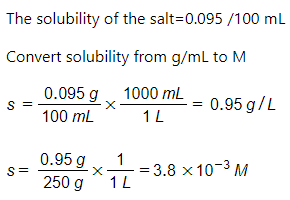The solubility of a hypothetical salt (A2B) is 0.095 g/100. mL at 25°C (hint: element A is in group 1A while element B is in group 6A). What is the value of the solubility product constant? The molar mass of this salt is 250.0 g/mol.
Ionic Equilibrium
Chemical equilibrium and ionic equilibrium are two major concepts in chemistry. Ionic equilibrium deals with the equilibrium involved in an ionization process while chemical equilibrium deals with the equilibrium during a chemical change. Ionic equilibrium is established between the ions and unionized species in a system. Understanding the concept of ionic equilibrium is very important to answer the questions related to certain chemical reactions in chemistry.
Arrhenius Acid
Arrhenius acid act as a good electrolyte as it dissociates to its respective ions in the aqueous solutions. Keeping it similar to the general acid properties, Arrhenius acid also neutralizes bases and turns litmus paper into red.
Bronsted Lowry Base In Inorganic Chemistry
Bronsted-Lowry base in inorganic chemistry is any chemical substance that can accept a proton from the other chemical substance it is reacting with.
![**Question 3: Solubility and Solubility Product Constant Calculation**
The solubility of a hypothetical salt \( \text{A}_2\text{B} \) is 0.095 g/100 mL at 25°C. (Hint: Element A is in group 1A while element B is in group 6A.) What is the value of the solubility product constant? The molar mass of this salt is 250.0 g/mol.
---
**Explanation for Educational Context:**
This question involves calculating the solubility product constant (\( K_{sp} \)) for the salt \( \text{A}_2\text{B} \). Here's how you approach it:
1. **Determine Molar Solubility**:
- Find the molarity of the dissolved salt using its solubility in grams per 100 mL and its molar mass.
2. **Write the Dissociation Equation**:
- The salt \( \text{A}_2\text{B} \) dissociates into 2A\(^+\) and B\(^{2-}\) ions.
3. **Calculate Ion Concentrations**:
- Use the stoichiometry of the dissociation reaction to find the molar concentrations of the ions in solution.
4. **Calculate \( K_{sp} \)**:
- Use the ion concentrations to compute the \( K_{sp} \) using the expression: \( K_{sp} = [A^+]^2[B^{2-}] \).
This exercise helps students understand solubility, stoichiometry, and equilibrium concepts related to inorganic salts.](/v2/_next/image?url=https%3A%2F%2Fcontent.bartleby.com%2Fqna-images%2Fquestion%2F485c3033-fba7-4e27-bc3f-5d79c440a1f8%2F2d59b609-ecdc-463f-aa29-fcafdef7364f%2Fjc9in3y6_processed.jpeg&w=3840&q=75)

Step by step
Solved in 2 steps with 2 images









